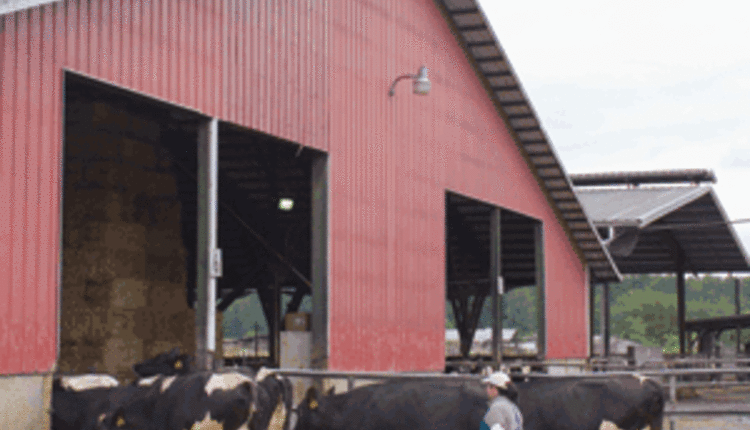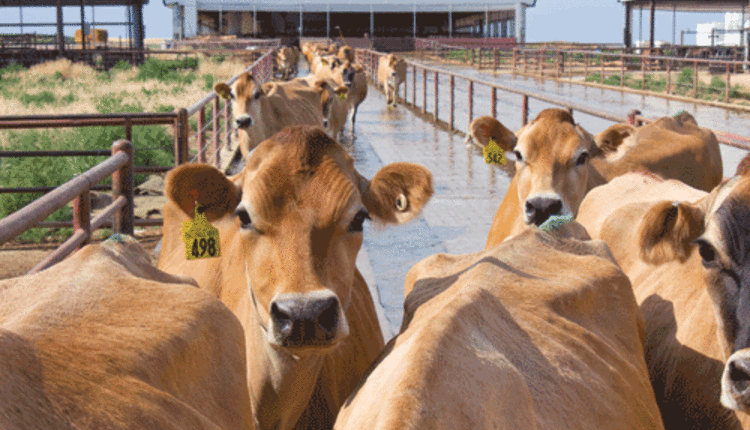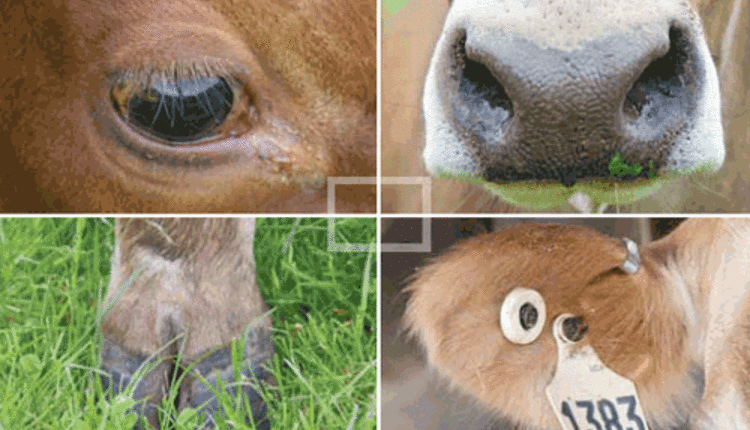Thomas is an author of many livestock books and owns a beef cattle herd with her husband in Salmon, Idaho. She wrote this series with Paul Rapnicki, D.V.M., formerly with the University of Minnesota School of Veterinary Medicine (UMN-SVM) and Don Höglund, D.V.M., currently with the UMN-SVM.
We frequently invade the personal space of cattle. When a person encroaches upon that personal space around a cow, the animal reacts based upon the position, timing, angle and speed. Learning these factors helps us use animals' natural and learned behaviors to move them around the dairy.

Cows move in an arc around you. This way they can keep an eye on the stimulus (you).
Cattle have almost the same ability to hear high pitches as dogs and hear low sounds much better than humans. Researchers have found that cattle show almost as much aversion to human shouting as they do to being hit by paddles and poked by prods. As a result, noise such as yelling and loud talking/music, banging on railings, whistling and ringing bells cause as much confusion to cattle as does poking. Noise is not a replacement for appropriate human body position.
Low stress movement of cattle requires people to control the types and levels of stimulation. Keeping your thumbs locked in your pants' pocket forces you to keep your hands down. A rocking motion is a very effective technique to apply pressure to cattle in alleys and small pens.
Small movements are best, especially in confined spaces since we are close to the animal's personal space. Whether we are moving cattle into or out of the milking parlor, into other pens or corrals or onto transport, we know that our position relative to the cow, our angle of approach, our timing and the rate at which we approach will determine if cattle move as intended, stop or turn back to face us.
Each time we need to move cattle, the task should be handled with cow behavior in mind. Cows react predictably if we remember that our actions prompt their reactions. There is no complicated or magic formula. The cow's behavior will inform the handler if the angle, speed and timing were correct. If she didn't respond as the handler intended, then the handler should back up along the same line as the approach, change the angle and the speed of approach.
Safely move cows to the parlor
Avoid startling the cows as you enter the pen. As you initiate movement among the herd, remember that the goal is to induce them to move out of the pen and toward the milking parlor. Your movements should be directed to create movement toward the parlor and to avoid any stimuli that would direct the cows away from the parlor.
Cows tend to move in an arc around whatever they perceive as stimulus. This allows them to keep an eye on what is pressuring them as they move around or away from it. Cows also tend to follow other cows. These two concepts are invaluable when emptying a cattle pen.
If the handler can create positive motion at the front of the herd and then avoid doing anything to slow or stop the flow, cows will tend to move in the direction they are facing while following the cow in front of them.
There is no problem with "multitasking" while moving cows out of a pen, as long as a person pays attention so that the movements performing these additional tasks do not interfere with directing the cows out of the pen and toward the milking parlor.
When movement out of a pen is started properly, it is usually easy to sustain by using stockmanship techniques to drive cattle - walking in straight lines in zigzag fashion from the back of the pen. When the motion toward the parlor is started properly, the leading cows will act a "draw" to the other cows in the pen. As you drive the cows, from the rear of the pen, they will readily head in the same direction as the lead cows. Entering a pen properly and starting the movement with good stockmanship techniques is critical to safe and efficient movement to the parlor.
The task of moving cows from the holding pen into the milking parlor will be made much easier when the cows are brought to the holding area safely and efficiently as described above. The cows are calm, relaxed and already heading in the direction needed to enter the parlor.
Loading milking parlor effectively
Your goal is to induce movement into the parlor using the stockmanship techniques we have been discussing. With recently fresh cows, especially first-lactation heifers exposed to the parlor for the first time, you will need to spend more time applying pressure (getting closer to their personal space) to get them to enter the parlor.
Once they have learned to enter the parlor, the amount of effort needed to induce movement into the parlor is greatly reduced. The time and effort invested in properly training the fresh cattle to enter the parlor will pay dividends for the remainder of their lactation.
Nearly all holding areas have a crowd gate to assist in loading the parlor. Crowd gates are an excellent example of technology that must be used properly. Proper use of the crowd gate allows workers to maintain proper space in the holding area for the number of animals. Crowd gates should not push the cows into the milking parlor.
In the holding area, proper pressure should be applied by the worker nearest the entrance to the parlor. Apply pressure so that cows are induced to go past the pressure and into the milking parlor. When done properly, you avoid turning the cows away from the parlor entrance and back toward the crowd gate.
If you notice cows turning away from the parlor entrance, take a critical look at what stimulus is inducing that behavior. Frequently, the stimulus that turns cows away from the parlor entrance is the speed, angle or timing of workers' movements as the cows enter the holding pen.
Returning cows from the parlor to their pen is easy when we first properly brought the cows to the holding area, enticed them into the milking parlor and milked them. Cows that leave the parlor calm and relaxed will be easy to return to the pen where they can find water and fresh feed. If you are having trouble returning the cows to the pen, you need to take a close look at all the steps that have occurred prior to exiting the parlor.
Each time cattle are worked properly they learn and become easier to work the next time. When farms only work cattle for specific tasks (such as vaccinating), a negative impression of handling can be imprinted in the cows' memory.
Negative interactions can make cows become harder to handle over time. Invest some time and effort in properly working and training fresh animals to enter the milking parlor calmly. We must understand that current behavior of a cow is the sum total of her interactions with humans over her lifetime; positive and negative.
We frequently invade the personal space of cattle. When a person encroaches upon that personal space around a cow, the animal reacts based upon the position, timing, angle and speed. Learning these factors helps us use animals' natural and learned behaviors to move them around the dairy.

Cattle have almost the same ability to hear high pitches as dogs and hear low sounds much better than humans. Researchers have found that cattle show almost as much aversion to human shouting as they do to being hit by paddles and poked by prods. As a result, noise such as yelling and loud talking/music, banging on railings, whistling and ringing bells cause as much confusion to cattle as does poking. Noise is not a replacement for appropriate human body position.
Low stress movement of cattle requires people to control the types and levels of stimulation. Keeping your thumbs locked in your pants' pocket forces you to keep your hands down. A rocking motion is a very effective technique to apply pressure to cattle in alleys and small pens.
Small movements are best, especially in confined spaces since we are close to the animal's personal space. Whether we are moving cattle into or out of the milking parlor, into other pens or corrals or onto transport, we know that our position relative to the cow, our angle of approach, our timing and the rate at which we approach will determine if cattle move as intended, stop or turn back to face us.
Each time we need to move cattle, the task should be handled with cow behavior in mind. Cows react predictably if we remember that our actions prompt their reactions. There is no complicated or magic formula. The cow's behavior will inform the handler if the angle, speed and timing were correct. If she didn't respond as the handler intended, then the handler should back up along the same line as the approach, change the angle and the speed of approach.
Safely move cows to the parlor
Avoid startling the cows as you enter the pen. As you initiate movement among the herd, remember that the goal is to induce them to move out of the pen and toward the milking parlor. Your movements should be directed to create movement toward the parlor and to avoid any stimuli that would direct the cows away from the parlor.
Cows tend to move in an arc around whatever they perceive as stimulus. This allows them to keep an eye on what is pressuring them as they move around or away from it. Cows also tend to follow other cows. These two concepts are invaluable when emptying a cattle pen.
If the handler can create positive motion at the front of the herd and then avoid doing anything to slow or stop the flow, cows will tend to move in the direction they are facing while following the cow in front of them.
There is no problem with "multitasking" while moving cows out of a pen, as long as a person pays attention so that the movements performing these additional tasks do not interfere with directing the cows out of the pen and toward the milking parlor.
When movement out of a pen is started properly, it is usually easy to sustain by using stockmanship techniques to drive cattle - walking in straight lines in zigzag fashion from the back of the pen. When the motion toward the parlor is started properly, the leading cows will act a "draw" to the other cows in the pen. As you drive the cows, from the rear of the pen, they will readily head in the same direction as the lead cows. Entering a pen properly and starting the movement with good stockmanship techniques is critical to safe and efficient movement to the parlor.
The task of moving cows from the holding pen into the milking parlor will be made much easier when the cows are brought to the holding area safely and efficiently as described above. The cows are calm, relaxed and already heading in the direction needed to enter the parlor.
Loading milking parlor effectively
Your goal is to induce movement into the parlor using the stockmanship techniques we have been discussing. With recently fresh cows, especially first-lactation heifers exposed to the parlor for the first time, you will need to spend more time applying pressure (getting closer to their personal space) to get them to enter the parlor.
Once they have learned to enter the parlor, the amount of effort needed to induce movement into the parlor is greatly reduced. The time and effort invested in properly training the fresh cattle to enter the parlor will pay dividends for the remainder of their lactation.
Nearly all holding areas have a crowd gate to assist in loading the parlor. Crowd gates are an excellent example of technology that must be used properly. Proper use of the crowd gate allows workers to maintain proper space in the holding area for the number of animals. Crowd gates should not push the cows into the milking parlor.
In the holding area, proper pressure should be applied by the worker nearest the entrance to the parlor. Apply pressure so that cows are induced to go past the pressure and into the milking parlor. When done properly, you avoid turning the cows away from the parlor entrance and back toward the crowd gate.
If you notice cows turning away from the parlor entrance, take a critical look at what stimulus is inducing that behavior. Frequently, the stimulus that turns cows away from the parlor entrance is the speed, angle or timing of workers' movements as the cows enter the holding pen.
Returning cows from the parlor to their pen is easy when we first properly brought the cows to the holding area, enticed them into the milking parlor and milked them. Cows that leave the parlor calm and relaxed will be easy to return to the pen where they can find water and fresh feed. If you are having trouble returning the cows to the pen, you need to take a close look at all the steps that have occurred prior to exiting the parlor.
Each time cattle are worked properly they learn and become easier to work the next time. When farms only work cattle for specific tasks (such as vaccinating), a negative impression of handling can be imprinted in the cows' memory.
Negative interactions can make cows become harder to handle over time. Invest some time and effort in properly working and training fresh animals to enter the milking parlor calmly. We must understand that current behavior of a cow is the sum total of her interactions with humans over her lifetime; positive and negative.
This article appears in Hoard's Dairyman on page 571 of the September 10, 2012 issue.









